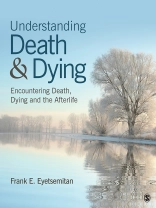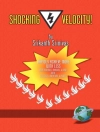Understanding Death and Dying teaches students about death, dying, bereavement, and afterlife beliefs by asking them to apply this content to their lives and to the world around them. Students see differing cultural experiences discussed in context with key theories and research. The text’s pedagogy delivers relevant multi- and cross-cultural applications and connections across topics. This helps students evaluate their personal assumptions and appreciate how the content applies to their own current and future roles as individuals, family members, work colleagues, and as part of a community. The text simultaneously challenges learners to consider their own perspectives and to think critically about the parallels between their own lives and different cultures.
Included with this title:
The password-protected Instructor Resource Site (formally known as SAGE Edge) offers access to all text-specific resources, including a test bank and editable, chapter-specific Power Point® slides.
Tabella dei contenuti
Preface
Acknowledgments
About the Author
Chapter 1: Attitudes Toward Death and Dying
Learning Objectives
Real Life
Understanding Attitude
Chapter 2: The Socialization of Death and Dying
Learning Objectives
Real Life
Death Socialization: Person and Environment Interaction
Death Socialization in Childhood
Death Socialization in Adolescence
Death Socialization in Adulthood
Chapter 3: Historical and Cultural Perspectives on Death and Dying
Learning Objectives
Real Life
History of Death
Triarchical Environment of Developing Societies
Historical and Cultural Death and Dying Practices
Chapter 4: Death Systems
Learning Objectives
Real Life
The Event of Death
Societal Systems that can Contribute to Death
Societal Systems that can Help Prevent Death
Systems that can Help Restore Society after a Death
Conclusion
Chapter 5: Healthcare
Learning Objectives
Real Life
Death Prevention
Death Acceptance
Accepting Medical Help
Guidelines on What to Say to a Dying Person
Chapter 6: End-of-Life Decisions
Learning Objectives
Real Life
Medical Ethics in End-of-Life Decisions
End-of-Life Decisions Pertaining to Oneself
End-of-Life Decisions Pertaining to Loved Ones
End-of-Life Issues and Decisions in Another Culture
Factors Prompting End-of-Life Decisions
End-of-Life Decision Making by a Third Party
Chapter 7: Views and Treatment of Life-Threatening Diseases
Learning Objectives
Real Life
Life-Threatening Diseases: Overview
Life-Threatening Diseases: Trajectories
Living with a Life-Threatening Disease
Pain Management
Chapter 8: Death Rituals and Final Act on Dead Bodies
Learning Objectives
Real Life
Last Rites
Rituals
Death Rituals
Final Act on Dead Bodies
History of Death Practices in the United States
Modern Funeral Practice in the United States
Federal Trade Commission’s Funeral Rule
Traditional Funeral
Military Funeral
Casket
Vault or Outer Burial Container
Outer Burial Liner
Professional Services by Funeral Homes
Modern Funeral Practice in Another Society
Chapter 9: The Experience of Loss
Learning Objectives
Real Life
Understanding a Loss
Theories and Models of Bereavement
The Experience of Loss: Direct and Indirect
Bereavement and Grief
Types of Loss Experiences: The Death of a Loved One
Multiple Loss Experiences
Grief: Normal Versus Complicated
Post-Traumatic Stress Disorder (PTSD)
Chapter 10: The Dying Experiences of Children and Adolescents
Learning Objectives
Real Life
Changes in Death Attitude Throughout Life
The Dying Experiences of Children
The Dying Experiences of Adolescents
Integrating Cultural Diversity
Conclusion
Chapter 11: The Dying Experiences of Adults
Learning Objectives
Real Life
Adults′ Understanding of Death
Death Anxiety in Adults
Death Anxiety Management
End-of-Life Conditions and Death Anxiety
Death Experiences in the Life of an Adult
Coping with a Loss
Positive Growth from a Loss
Chapter 12: Suicide
Learning Objectives
Real Life
Terminologies for Suicide Communication
Suicide as Cry for Help
Suicide as Escape from Self
Lifespan Developmental Model of Suicide
Cultural Factors in Suicide
Theories Explaining Suicide
Suicide across Different Age Groups
Suicide Prevention
Chapter 13: Death Caused by Accidents, Violence, and Trauma
Learning Objectives
Real Life
Deaths Caused by Accidents
Deaths Caused by Violence
Death Caused by Trauma
Chapter 14: Afterlife Beliefs
Learning Objectives
Real Life
Afterlife Beliefs
The History of Afterlife Beliefs in the United States
Afterlife Beliefs about Animals
The Human Predisposition to Believe in an Afterlife
Near-Death Experiences
Biopsychological Explanations for Near-Death Experiences
The Future of Afterlife Beliefs
Chapter 15: The Way Forward
Learning Objectives
Real Life
Embracing Life
Evaluating Personal and Social Choices
Social Choice by Incentives and Disincentives
Applicable Motivational Principles and Theories on Social Choice
Embracing Death
End-of-Life Decisions
Coexistence of Living and Dying Thoughts
Good Life and Good Death
Farewells
The Future of Death and Dying
Glossary
References
Circa l’autore
Frank Eyetsemitan is a Professor of Psychology at Roger Williams University in Bristol Rhode Island, where he previously served as the Associate Dean of the Social Sciences Division, College of Arts and Sciences. He is also a Faculty Associate at the UMaine Center on Aging and a Trustee of the Providence Public Library. Dr. Eyetsemitan is the author or co-author of several publications on death, dying and bereavement.












